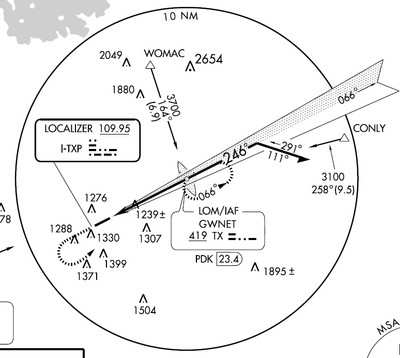Mon, Jan 15, 2007
Crash Claimed Three During Second Instrument Approach
Attempt
 The NTSB has issued a preliminary
report on the December 25, 2006 crash of a Cessna 414 in
Lawrenceville, GA. According to the report, Michael Mucha, a
certificated private pilot, was attempting a second night, ILS
approach to runway 25 at Gwinnett County Airport (LZU) when the
aircraft impacted trees and an asphalt conveyer machine 1,100 feet
left of the runway's centerline. Mucha, his wife Norma Ann and
their daughter Samantha were all lost in the crash.
The NTSB has issued a preliminary
report on the December 25, 2006 crash of a Cessna 414 in
Lawrenceville, GA. According to the report, Michael Mucha, a
certificated private pilot, was attempting a second night, ILS
approach to runway 25 at Gwinnett County Airport (LZU) when the
aircraft impacted trees and an asphalt conveyer machine 1,100 feet
left of the runway's centerline. Mucha, his wife Norma Ann and
their daughter Samantha were all lost in the crash.
The NTSB says Atlanta Center reported the weather at LZU
prior to Mucha's first approach attempt as winds calm, visibility
1/2 mile in fog with a 100 foot ceiling -- published minimums for
the ILS Rwy 25 approach at LZU require a 200 foot ceiling. Mucha
acknowledged the weather and elected to continue the approach.
Mucha contacted tower on final reporting he had the current
weather. He executed a missed approach on his first ILS attempt
informing the tower controller he'd seen the airport and
wanted to make another approach attempt.
The Atlanta Center controller vectored Mucha around for another
ILS Rwy 25 approach before handing him off to tower again on final.
Both center and tower controllers gave him updated weather for the
airport -- the same as previously reported.
While on short final for runway 25, the LZU tower controller
told Mucha he was left of the runway centerline. Shortly after
receiving acknowledgement from Mucha, the controller saw a bright
"orange glow" off the left side of the approach end of runway 25.
After making several unsuccessful attempts to reach Mucha by radio,
the tower controller reported the aircraft missing to emergency
personnel.

The wreckage was located in an asphalt plant approximately 1
mile short of runway 25. The debris was 1,100 feet left of the
runway's extended centerline. NTSB investigators determined the
aircraft impacted trees before colliding with the conveyor machine.
The debris line was 426 feet long on a 290-degree heading.
More News
Light Gun A handheld directional light signaling device which emits a brilliant narrow beam of white, green, or red light as selected by the tower controller. The color and type of>[...]
"The journey to this achievement started nearly a decade ago when a freshly commissioned Gentry, driven by a fascination with new technologies and a desire to contribute significan>[...]
Aero Linx: JAARS, Inc. For decades now, we’ve landed planes on narrow rivers and towering mountains. We’ve outfitted boats and vehicles to reach villages that rarely se>[...]
"Our driven and innovative team of military and civilian Airmen delivers combat power daily, ensuring our nation is ready today and tomorrow." Source: General Duke Richardson, AFMC>[...]
Aircraft Conflict Predicted conflict, within EDST of two aircraft, or between aircraft and airspace. A Red alert is used for conflicts when the predicted minimum separation is 5 na>[...]
 ANN's Daily Aero-Term (04.20.24): Light Gun
ANN's Daily Aero-Term (04.20.24): Light Gun Aero-News: Quote of the Day (04.20.24)
Aero-News: Quote of the Day (04.20.24) ANN's Daily Aero-Linx (04.21.24)
ANN's Daily Aero-Linx (04.21.24) Aero-News: Quote of the Day (04.21.24)
Aero-News: Quote of the Day (04.21.24) ANN's Daily Aero-Term (04.21.24): Aircraft Conflict
ANN's Daily Aero-Term (04.21.24): Aircraft Conflict




